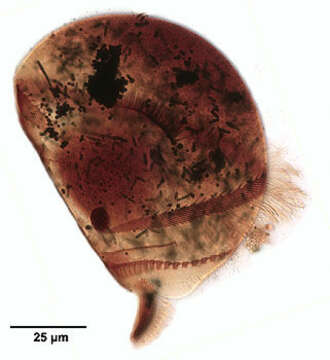Infraciliature

Kuvaus:
Silver carbonate preparation (see Foissner, W.Europ. J. Protistol.27, 313-330; 1991) of the sapropelic armophorid ciliate, Caenomorpha uniserialis (Levander, 1894), left lateral view. The cell body is parachute-shaped with a smooth broad anterior shield. The anterior shield bears a single file of cirri-like cilia (seen well here). The body terminates posteriorly in two spinous processes, a short simple one (not seen in this image) and a complex terminal longer spine with folds, projections and several rows of cilia. The perizonal ciliary stripe originates on the left lateral aspect anteriorly and makes a complete turn around the body along the spiraling peristome and terminates on the same longitudinal line posteriorly (seen well here). The area of the cytostome is between the two spinous processes at the posterior end of the peristome. An adoral zone of membranelles parallels the spiral peristome (seen well here). An undulating membrane originates near the posterior end of the perizonal stripe and terminates at the cytostome (seen as a thin dark line in this image). The single large spherical macronucleus and the overlying micronucleus are seen well here. The cytoplasm contains several forms of endosymbiotic bacilli (stained dark black in this image). The contractile vacuole (not seen here) is located at the base of the large spine. C. uniserialis is bactiverous. Collected from stagnant freshwater bottom sediment with rotting leaves and rich in hydrogen sulfide near Boise, Idaho August 2004. Brightfield optics.
Mukana seuraavilla sivuilla:
- Life
- Cellular
- Eukaryota (aitotumaiset)
- SAR (Stramenopiles, Alveolates, Rhizaria)
- Alveolata (Alveolaatit)
- Ciliophora (Ripsieläimet)
- Intramacronucleata
- Armophorea
- Armophorida
- Caenomorphidae
- Sulfonecta
- Sulfonecta uniserialis
Tämä kuva ei ole esillä missään kokoelmassa.
Lähdetiedot
- lisenssi
- cc-by-nc
- tekijä
- William Bourland
- tarjoaja
- micro*scope
- alkuperäinen
- alkuperäinen mediatiedosto
- käy lähteessä
- kumppanisivusto
- micro*scope
- ID


